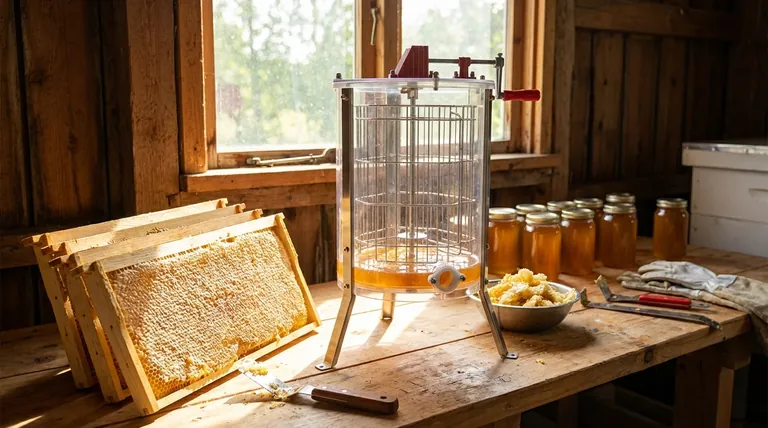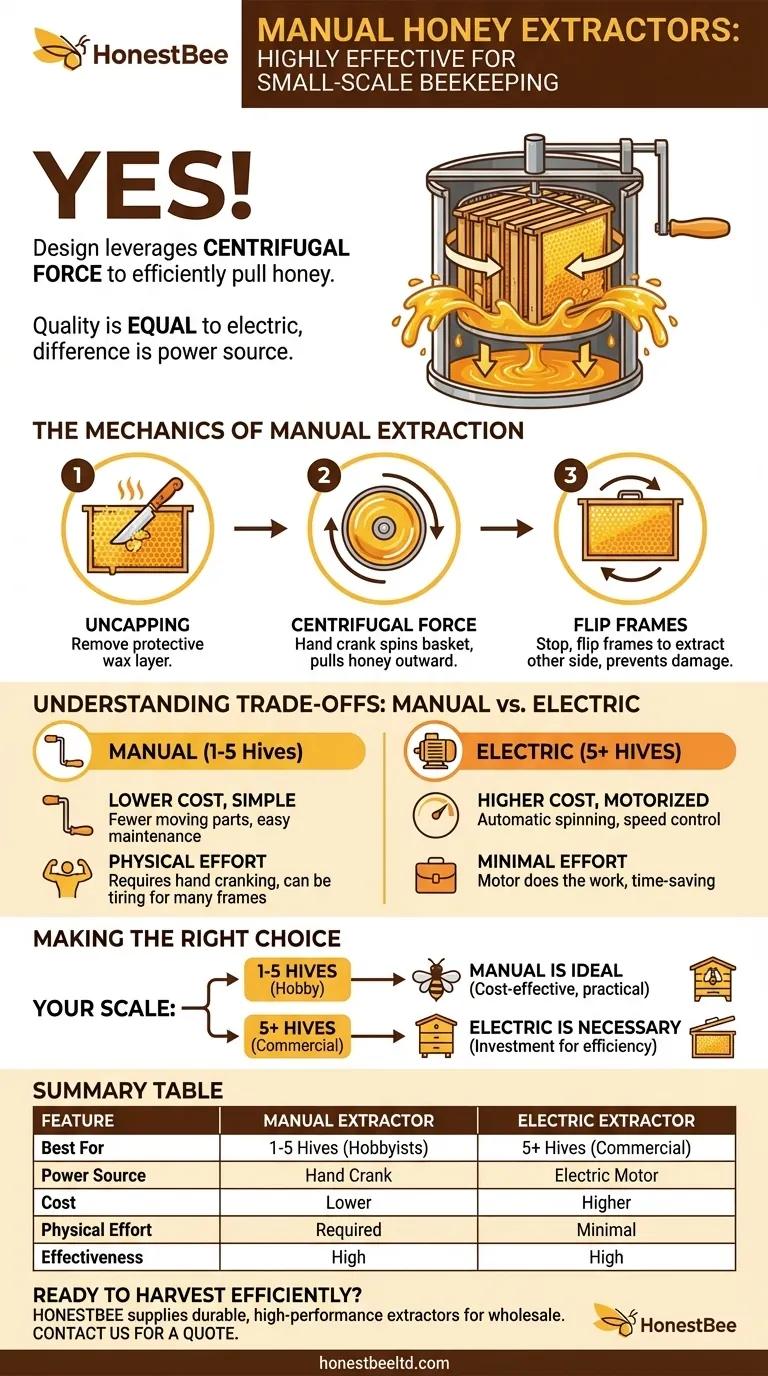Yes, a manual honey extractor is highly effective at removing honey from the comb. Its design leverages centrifugal force to efficiently pull honey from the cells, making it a standard and reliable tool for beekeepers. The primary difference from an automatic extractor is not in the quality of the extraction, but in the source of power—your own physical effort.
The decision between a manual and an automatic extractor is not about effectiveness, but about scale. A manual extractor is the perfect tool for a small-scale or hobbyist beekeeper, while an automatic model is a necessary investment for larger, commercial-scale operations.

The Mechanics of Manual Extraction
To understand why a manual extractor works so well, you must first understand the process. It is a simple but effective application of physics that has been used by beekeepers for over a century.
The Critical First Step: Uncapping
An extractor can only remove honey from cells that are open. Before placing frames in the extractor, you must first remove the protective wax layer that bees build over cured honey.
This is done using a specialized tool. Beekeepers typically use a heated uncapping knife or an electric uncapping plane to slice off the top layer of wax, or a cappings scratcher to pierce and open the individual cells.
Centrifugal Force at Work
Once uncapped frames are placed in the extractor's basket, you begin turning the hand crank. This spins the basket, creating a powerful centrifugal force.
This force pulls the liquid honey outward from the cells and onto the inner wall of the extractor drum. The honey then runs down the wall and collects at the bottom.
The Importance of Flipping Frames
Most manual extractors are "tangential," meaning they hold the frame with one side facing out. After spinning for a few minutes, you must stop, flip each frame to expose the other side, and spin again.
Starting slowly and flipping the frames prevents the weight of the honey on the un-extracted side from "blowing out" or destroying the delicate wax comb.
Understanding the Trade-offs: Manual vs. Electric
The effectiveness of a manual extractor is not in question, but its suitability for your specific needs depends on a few key trade-offs compared to its electric counterpart.
Cost and Simplicity
Manual extractors are significantly less expensive than electric models. With fewer moving parts and no motor, they are also simpler to maintain and less likely to have mechanical failures.
Physical Effort and Time
This is the main consideration. A manual extractor requires you to provide the power by cranking the handle. While not excessively strenuous for a few hives, extracting honey from a large number of frames can be a time-consuming and tiring workout.
Scale of Operation
The number of hives you manage is the most important factor. An electric extractor is powered by a motor, spinning frames automatically and often at higher, controlled speeds.
A manual extractor is perfectly suited for a beekeeper with 1 to 5 hives. An electric model becomes a practical necessity for anyone managing more than 5-10 hives, where the time and labor savings justify the higher cost.
Making the Right Choice for Your Apiary
Choosing the right equipment is about aligning the tool with your operational goals.
- If your primary focus is hobby beekeeping (1-5 hives): A manual extractor is a cost-effective, reliable, and highly practical tool that will meet all of your needs.
- If your primary focus is growing a larger apiary (5+ hives) or you have physical limitations: An electric extractor is a worthwhile investment that will save you significant time and labor during harvest.
Ultimately, a manual extractor is a proven and effective tool that empowers any small-scale beekeeper to harvest their own honey successfully.
Summary Table:
| Feature | Manual Extractor | Electric Extractor |
|---|---|---|
| Best For | 1-5 Hives (Hobbyists) | 5+ Hives (Commercial) |
| Power Source | Hand Crank | Electric Motor |
| Cost | Lower | Higher |
| Physical Effort | Required | Minimal |
| Extraction Effectiveness | High | High |
Ready to harvest your honey efficiently?
Whether you're a hobbyist starting out or a commercial apiary scaling up, having the right equipment is key to a successful harvest. HONESTBEE supplies durable, high-performance beekeeping supplies and equipment—including manual and electric honey extractors—to commercial apiaries and beekeeping equipment distributors through our wholesale-focused operations.
Let us help you choose the perfect extractor for your needs. Contact our experts today to discuss your operation and get a quote!
Visual Guide

Related Products
- HONESTBEE 3-Frame Manual Acrylic Honey Extractor
- Plastic Hand Crank 2 Frame Honey Extractor Low Price
- 8-Frame Electric Self-Reversing Honey Extractor Spinner for Commercial Honey Extraction Equipment
- HONESTBEE Advanced Ergonomic Stainless Steel Hive Tool for Beekeeping
- Professional Dual-End Stainless Steel Hive Tool for Beekeeping
People Also Ask
- How do you collect honey at home? A Beginner's Guide to Harvesting from Your Hive
- How to extract honey by hand? A Guide to Crush & Strain vs. Manual Extractors
- What is the most common method for cleaning a honey extractor? Protect Your Honey & Equipment
- What machines are needed in beekeeping besides basic tools? Scale Your Honey Harvest Efficiently
- What equipment is used for honey harvest? Essential Tools for Every Beekeeper



















